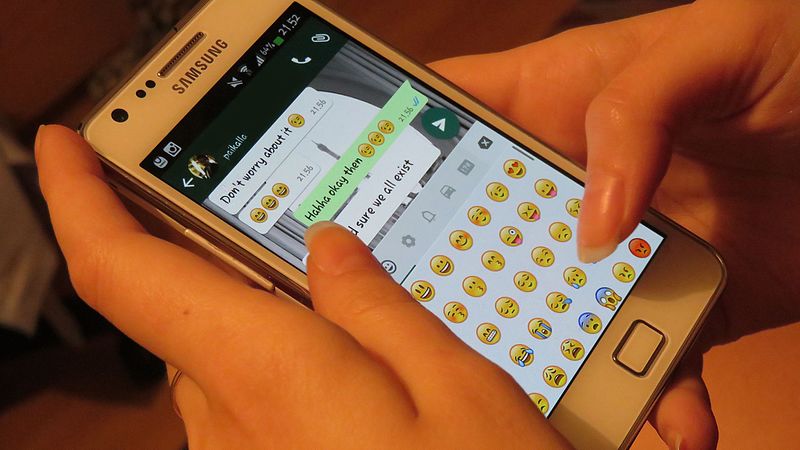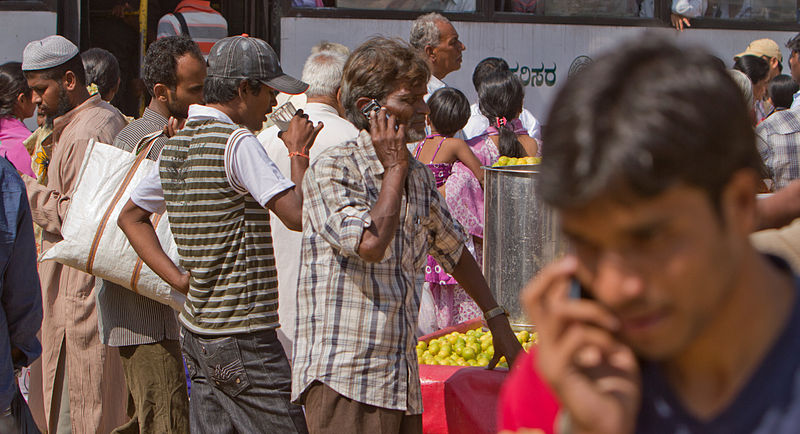WhatsApp in India / इंडिया में व्हाट्सऐप Posted by Rachael on Oct 21, 2018 in Hindi Language, Uncategorized
Some of you may be familiar with the popular messaging app known as “Whatsapp” (व्हाट्सऐप). In India and many other countries, this app is widely used as a major form of communication (संचार का प्रमुख माध्यम/sanchaar ka pramukh maadhyam) as you can call, text and video chat through its service for free as long as you have an internet connection. However, like most social media tools that have been in the news lately, such as Twitter and Facebook, this service has the potential to be used for ill rather than simply connecting people despite geographic distance. This misuse (दुरुपयोग/durupyog or ग़लत इस्तेमाल/galat istemaal, masc. nouns) of the service is on glaring display in India, where Whatsapp groups composed of family and/or community members or friends can share information quickly with large amounts of people, often without verifying the source of the information and whether or not that source is trustworthy. As a result of this wide sharing of misinformation (झूठी खबर/jhoothi khabar, fem. noun or झूठा समाचार/jhoothaa samaachaar, masc. noun), numerous people have lost their lives.
Read this article for more information on the spread of falsehoods on social media services like Whatsapp.
In this article from July 2018, the author discusses a number of warnings (चेतावनी/chetaavni, fem. noun) the Indian government has issued to the popular messaging company, Whatsapp. As a result of mass sharing of misinformation, several people have been killed at the hands of mobs in India. In response to these horrific incidents (भयानक घटनाएँ/bhayaanak ghatnaae, fem. noun), the Indian government pressured Whatsapp to restrict the sharing capabilities of its users. Thus, in a blog on its website, Whatsapp explained that it was testing limits (सीमाएँ/seemaaee, fem. noun) on the number of times a piece of information could be shared and on the number of people with whom a user could share it (साझा करना/saajhaa karnaa).
India uses the popular messaging service (लोकप्रिय संदेश भेजने की सेवा/lokpriya sandesh bhejne ki sevaa, fem. noun), which is also immensely popular in countries such as Brazil, Mexico and Russia, more than all other countries worldwide, with more than 20 crore users in the country alone (करोड़/crore is just a simplified way of expressing the quantity ten million, so 20 crore is 200 million). By enacting new limits on sharing capabilities, Whatsapp hopes to curb the potential harm that can be done with its service and enhance the benefits the service already provides – the ability to share moments of your life and communicate with loved ones, community members and friends (रिश्तेदार वाले या प्रियजन, समुदाय के सदस्य और दोस्त/rishtedaar vaale yaa priyajan, samudaay ke sadasya aur dost).
As part of these limits, Whatsapp groups can contain no more than 256 members (सदस्य/sadasya, masc. noun). To further combat the negative effects of sharing often hateful misinformation on its platform, Whatsapp stated that Indian users specifically would not be allowed to forward any piece of information more than five times (पाँच बार/paanch baar, fem. noun). Unfortunately, this limitation does not stop people within a group, already circulating a potential piece of misinformation widely within the group, from then forwarding the message onto five other people outside of the group. In addition, the “forward button” that usually appears right next to messages with pictures and videos will be removed (हटाना/hataanaa) to prevent over-sharing of misinformation.
In response to reports of over 18 people dying from April to July 2018 as a result of misinformation campaigns spread on Whatsapp, the Indian government pressured (दबाव करना/dabaav karnaa) the company to make changes to its policies in an attempt to stop such incidents in the future. In one incident, strangers (अजनबी/ajnabi, masc. and fem. noun) were killed by a mob when it was thought that they were behind a child kidnapping (बच्चा अपहरण/baccha apaharan, masc. noun). The situation had become so grave that, even when the government of Tripura, a state in northeast India, sent an individual from one village to the next to spread awareness (जागरूकता फ़ैलाना/jaagruuktaa failaanaa) on misinformation campaigns prevalent on social media, this individual himself was murdered by an angry mob because they mistook him for a child kidnapper.
Subsequent to these incidents, the Indian government’s ire toward Whatsapp only grew, to the point that they continually sent strong warnings to the company with the message that “वो (व्हाट्सऐप) यूज़र द्वारा साझा की गई सामग्री की “जवाबदेही और जिम्मेदारी” लेने से बच नहीं सकता” (“Whatsapp could not escape assuming accountability and responsibility for the materials shared by its users”). Whatsapp’s response to this was to express “shock” (हैरान/hairaan) at the violent incidents (हिंसक घटनाएँ/himsak ghatnaaee, fem. noun) that had occurred and the sentiment that “चुनौती से निपटने के लिए सरकार, आम लोगों और तकनीकी कंपनियों को साथ मिलकर काम करना होगा” (“The government, ordinary people and technology companies would have to work together to deal with the challenge”).
Of course, as the owner (मालिक/maalik) of Whatsapp, Facebook is also accountable (जवाबदार/javaabdaar) for the atrocious incidents that have occurred through the misuse of its messaging app. Indeed, such incidents and misinformation campaigns (ग़लत समाचार का अभियान/galat samaachaar ka abhiyaan) are also prevalent on Whatsapp’s parent company. True, most of us use social media to share special moments in our lives and to widen our social circles to include those who may be geographically distant from us – it is certainly a way of bringing people closer, across distance, time and culture, if used appropriately. Yet, as social media has become an inextricable part of most people’s lives, it is increasingly up to users to know when and how to use it properly, but it is especially the responsibility of technology companies to create and enforce rules for the protection (सुरक्षा/surakshaa, fem. noun) of its users and peaceful society as a whole.

Build vocabulary, practice pronunciation, and more with Transparent Language Online. Available anytime, anywhere, on any device.






